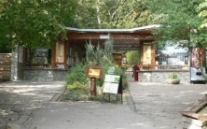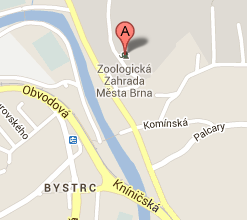After the successful breeding of two red-crowned cranes in 2014, our zoo entered into a program to repatriate red-crowned cranes and white-naped cranes, which is managed by Khingansky State Nature Reserve (Chinganskij gosudarstvennyj prirodnyj zapovednik) in the Amur region of the Russian Federation. The purpose of this program, which began in 1988, is to strengthen the wild populations of both of the aforementioned crane species by introducing individuals bred in partially wild conditions. The red-crowned crane (Grus japonensis), also known as the Japanese crane, is a bird of the order Gruiformes and the family Gruidae. This family contains four living genera (Anthropoides, Balearica, Bugeranus, and Grus). The red-crowned crane grows to a height of 140 cm and can weigh up to 15 kg. It lives in wetlands, and occurs in the Russian Far East, northeastern China (Manchuria), eastern Mongolia, and on the Japanese island of Hokkaido, with a total of approximately 1,700 sexually mature individuals. Continental populations are mostly birds of passage wintering in the delta of the Yellow River (Yangtze c‘tiang), on the coast of the Yellow Sea in China‘s Jiangsu Province, or in the area around the border of the two Korean states. The cranes which live in Hokkaido, however, do not leave the island but only retreat for the winter from the mountains to lower altitudes. While the Japanese population is numerically stable, those on the mainland have been decreasing. The Red List of Threatened Species of the World Organisation for Conservation of Nature (IUCN) classifies the red-crowned crane as Endangered. The European Association of Zoos and Aquariums (EAZA) has established (not only for this species, but also for seven other of the fifteen living species of cranes) restorative programs managed by a coordinator, whose job it is to find different locations in zoos for hatched individuals in order to avoid inbreeding. The white-naped crane (Antigone vipio) inhabits a similar area as the red-crowned crane. It nestles in the basin of the Amur on the Russian-Chinese border (especially in the area traditionally called Dauria, lying to the west of Manchuria and forming the northernmost extremity of Chinese territory), and winters in the valley of the Yellow River in China, in Korea, and in the large southern Japanese island of Kyushu. Its wild population is estimated at 5,500 to 6,500 individuals, but its abundance has been declining. The species is categorized as Vulnerable. The main causes of declining numbers of both species are the destruction and loss of their habitat, particularly the wintering areas. For example, the drying of wetlands in China, which began in the 1950s, brought about the disappearance of up to 90% of those wintering areas. Other negative effects include poaching, direct interference by man, and agricultural chemicals. In addition, people capture cranes for domestic breeding. Nests in both species usually contain only two eggs; thus the chance of a faster recovery of wild populations is declining. The population recovery process is additionally slow as a result of the fact that both these species don’t mature sexually for three or four years. Conversely, they have an advantage in their longevity, as cranes can live from 50 to 90 years.
The Breeding of Cranes in Brno Zoo
Brno Zoo currently breeds only red-crowned cranes, which are also in approximately 120 to 130 zoological institutions in Europe, the former Soviet Union, and the Middle East. In the Czech Republic, these cranes can be seen in ten zoos: Besides Brno Zoo, they are in Chomutov, Děčín, Hodonín, Jihlava, Olomouc, Pilsen, Prague, Ústí nad Labem, and Lešná zoos. The first individual of this species appeared in our zoo in 2005. It was a three-year-old female imported from Moscow Zoo, where she was bred artificially. A one-year-old male arrived in Brno in 2006 from a zoo in Vienna’s Schoenbrunn. Mating does not happen automatically with cranes, and placing two cranes of the opposite sex in a single paddock does not necessarily result in the hoped-for breeding. But our cranes began to show signs of sexual behaviour soon after the male attained sexual maturity: In 2008, we observed their first mating dance. In subsequent seasons the cranes already had built their nest and sat on the eggs, but another six years passed before we found the first fertilized egg. A male crane can fertilize a female only when he jumps on her and – of course, with the help of both wings - retains his balance; but birds held in captivity sometimes have problems because most of them have one wing trimmed. Males with trimmed wings, which include ours, must learn to keep their balance properly in order to mate successfully, which can take a very long time. We saw the first chicks in June 2014. One chick found a home in Hodonín Zoo, the other with a private breeder in Holland. The white-naped crane is bred in 100–120 zoological institutions in Europe. In the Czech Republic, these include zoos in Chomutov, Děčín, Olomouc, Ostrava, Pilsen, Prague, and Lešná.
Repatriation Program
The purpose of this program at Khingansky State Nature Reserve is to strengthen wild populations of both the mentioned cranes species by introducing individuals bred in partially wild conditions. With the help of the Eurasian Regional Association of Zoos and Aquariums (EARAZA), a station for the reintroduction of rare bird species was built for this purpose. In addition to a base in Arkhara, where the reserve is located, the station also has a summer institute on the shores of Lake Kleshenskoye (Ozero Kleshenskoye), about thirty kilometres from Arkhara. Juveniles of both species of cranes hatched in the station are being raised together by the staff, who then carry them to their home environment. There, they learn to look for natural food with the help of a man and one-year-older chicks. The first few weeks after hatching, the chicks remain in Arkhara. The conservationists then move them into the summer station at Lake Kleshenskoe. When the chicks are at least one month old, they are set free in the neighbourhood of the station during the day. (They are closed in cages only at night to protect them from predators.) At the age of around three months, the chicks begin to learn to fly and to move about the countryside alone. In the wilderness, parents care for their offspring for approximately 45 days. The cranes become fully independent only after one year of life. Cranes are migratory birds, but the ability to find the right migration path is not genetically coded. They have to learn it in their first year from their parents. Therefore, most chicks hatched at the station are not able to leave that same year. Instead, they are transported by helicopter or car to the wintering area in Arkhara. About a week before the arrival of the wild cranes from their natural wintering areas, the bred birds are again released into their natural environment. Only at the age of two years do they become interested in wild individuals of their species. They then try to establish contact or to pair with them. Conservationists from Khingansky State Nature Reserve have proven that cranes bred by people have paired with wild birds, then departed with them for wintering, and were able to return to the Reserve. Wild birds which have coexisted with man-bred birds have adapted better to a human presence, with fewer leaving their brood when alarmed by people. With white-naped cranes, the proven survival rate of freed chicks into their second year of life is up to 41.2%. A bird set free in 2002 has so far lived longest, being observed on the wintering grounds almost every year until 2013. The red-crowned crane has been reintroduced in Kushiro Crane Natural Park on the Japanese island of Hokkaido, in Zhalong National Nature Reserve in the Chinese province of Heilongjiang, and in Khingansky State Nature Reserve, which is the most important area of occurrence, with the highest degree of preservation of the species. In Russia, the red-crowned crane was originally introduced in 1988. Although the program of repatriation in Khingansky State Nature Reserve has been running for nearly three decades, few people know about it in Europe outside of Russia. The French Bioparc Doué La Fontaine worked with the station in Arkhara for only a short time. In contrast, the American Association of Zoos and Aquariums supported the Russian program for many years and sent several dozen fertilized eggs from the USA to Arkhara.
The First Transport
In the latter part of 2014 and into 2015, Brno Zoo signed a contract for the transportation of eggs for the repatriation program of cranes to the station in Arckara. The following half year was very difficult both administratively and logistically. The several hours’ time zone difference between Central Europe and the Far East didn’t help. However, on May 20, 2015, a transportation incubator containing two crane eggs, accompanied by the curator of aviculture from Brno Zoo, finally departed for an almost two-day-long gruelling journey from the Czech Republic to the Russian Far East. The preparation for this journey, particularly demanding in terms of obtaining various approvals, was complicated by the birds themselves because, in 2015, they began sitting on the eggs around the 20th of April, about two weeks earlier than in the previous five years. The issue became a race against time to prepare all the documents, complicated by the delay from the Russian authorities in giving us the necessary documents. While the cranes peacefully warmed their eggs, we lived in fear that we would not be able to put together all the papers before the chicks began to hatch. Crane eggs have a strong shell, so we were not able to determine by inspection whether they were fertilized. We had to use a special device to hear heart beats. In one egg, strong cardiac echoes were recorded, but the second ECG waveform was uncertain. Both eggs underwent the transport anyway. After a three-hour car ride from Brno to Prague, followed by a 15-hour flight via Moscow to Khabarovsk, we were on a train for eight hours to Arckara, which time was made even longer by several hours of waiting during transfers. Poultry eggs can be transported at a time when the embryo does not develop, but a crane egg has to be transported with an actively developing embryo inside because its development is more or less continuous from fertilization to hatching. Therefore, the eggs travelled during the peak stage of incubation, when the embryo was already larger and therefore more resistant to any possible concussion. We had to abandon the idea of a movable incubator with a connection to the mains or to a car battery because there are were no electrical outlets in the cargo hold of the aircraft, and a car battery could not be transported for security reasons. The transportation inkubátor was allowable as hand luggage only. So, we had to resort to a substitute solution and, following Russian methodology, transport the eggs in a dual-chamber timber box with insulated walls, heated only by hot-water bottles, and having dimensions such that it could be inserted in the plane’s overhead locker. The fertilized eggs had to remain under the constant surveillance of a zoo employee during the long journey. They required intensive care, as it was necessary to rotate them and to control the temperature and humidity in the incubator. It was symptomatic that the home-made inkubátor did not maintain proper temperatures, requiring the zoo worker go without sleep for two days in order to check the incubator at fifteen-minute intervals and to refill the hot-water bottles when necessary. After this painful journey, the egg-guide arrived at Arkhara completely exhausted. The voice of a crane chick coming from one egg in the reintroduction station meant satisfaction for us. Over the course of the next three days, it hatched. This small female, which was then banded with a white plastic ring with the mark 3KO, was named Kohany and was integrated into the program. She managed the first season successfully. This spring, conservationists finally let her free in the wild. The second egg turned out to be unfertilized.
The Second Transport
Chomutov Zoo, Olomouc Zoo, and Veldhoven Zoo in the Netherlands were also interested in the program of Khingansky State Nature Reserve after our first transportation. During the following months, contracts were prepared for the transfer of eggs from these zoos to ours for the purpose of transporting them to the Russian Far East. Our difficulty using a wooden crate led us to use a different incubator for the second transport. Specialists both in academic as well as in commercial circles have extensive experience with the transfer of biological samples stored at low temperatures. However, transport combined with heating has proven to be a methodological challenge. Only after random consultations with herpetologists engaged in transporting live reptiles did a solution become clear. Based on their experiences, and after further consultation with the security department of Vaclav Havel Airport Prague-Ruzyne and the Russian airline Aeroflot, we made a new incubator and verified that it could travel in compliance with international standards (IATA). It was constructed from a styrofoam crate and contained a thermostat, a heating plate, a fan, and a battery. The moment we finished constructing the incubator, we returned to the practice of collecting eggs from different pairs of cranes. In the wild, red-crowned cranes nest for 29 to 34 days, about as long as the white-naped crane. Nesting of the white-naped crane was confirmed in February, while the red- crowned crane doesn’t begin to nest until early April. The nesting season of both species in the wild ends in May, though later in captivity. The time span of the individual egg laying is therefore considerable, depending on local conditions. Cranes in Brno surprised us again when they set the record for early nesting, with the female sitting on the nest from April 13th. A week or so later, Olomouc Zoo announced the nesting of one of their two pairs of red-crowned cranes and one of their two pairs of white-naped cranes. The zoo in Veldhoven also reported the nesting of one pair of white-naped cranes. Zoo Chomutov’s cranes started sitting on 3 May. Two eggs were in each of the nests; but, from the beginning, it was clear that not all of them would travel to Arkhara. Workers of the local station told us that they are able to breed no more than six birds from our shipment in any one season. Six eggs were therefore planned for transport from Brno: two red-crowned crane eggs from Brno Zoo, and two of the same species from Olomouc Zoo, which also provided two white-naped crane eggs. A few days before departure, we found that one of the eggs of the red-crowned crane was unfertilized. Veldhoven Zoo would not transfer another egg from the Netherlands in such a short time, so the last egg which was incorporated into the transport was one laid in Chomutov Zoo. Workers of that zoo arrived carrying it directly into Ruzyně on the day of departure, May 13. The new incubator maintains the temperature and humidity better, and the eggs arrived the following day in Arkhara. Three days later, two red-crowned crane chicks from Brno Zoo hatched; then the white-naped crane from Olomouc Zoo; and, after another couple of days, the red-crowned cranes from Olomouc Zoo hatched, too. The egg of the white-naped crane from Chomutov Zoo eventually proved to be unfertilized. Five chicks from the Czech Republic will prepare for a return to the wilderness in the Russian Far East in the coming months. Brno Zoo plans - along with cooperating zoos – to continue participating in the repatriation program in the coming years.
RNDr. Petr Suvorov, Ph.D.






.jpg)
